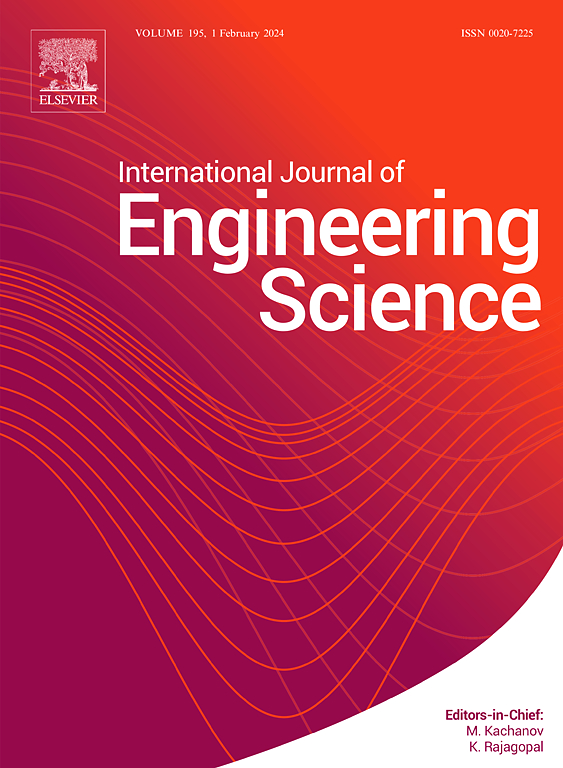周期动力学中非定域性的一个通用度量
IF 5.7
1区 工程技术
Q1 ENGINEERING, MULTIDISCIPLINARY
International Journal of Engineering Science
Pub Date : 2025-06-27
DOI:10.1016/j.ijengsci.2025.104338
引用次数: 0
摘要
在周期动力学中,影响函数决定了模型的“非定域性”,这取决于影响函数的支持(“视界大小”)及其特定形状。在本文中,我们引入了一个通用的标量参数-非定域性常数-来量化基于键的环动力模型中的非定域性相互作用的强度。非定域性常数严格地推导自非定域性因子,它是周期动力学方程解析解的关键组成部分,并与周期动力学解与经典解的差异建立了一一对应关系。通过分析8个不同的影响函数,我们证明了非定域性常数普遍地控制着周期动力响应相对于经典响应的偏差。利用本征函数展开得到的弹性膜挠度解析解,验证了该方法根据影响函数的非局域强度准确排序。这项工作为选择具有微观结构非均质材料的多尺度建模中的影响函数提供了一个系统的框架。本文章由计算机程序翻译,如有差异,请以英文原文为准。
A universal measure of nonlocality in peridynamics
In peridynamics, the influence function determines the “nonlocality” of the model, which depends on the support of the influence function (the “horizon size”) and its specific shape. In this paper, we introduce a universal scalar parameter - the nonlocality constant - to quantify the strength of nonlocal interactions in bond-based peridynamic models. The nonlocality constant derives rigorously from the nonlocal factor, a key component in analytical solutions of peridynamic equations, and establishes a one-to-one correspondence with the difference between peridynamic and classical solutions. By analyzing eight distinct influence functions, we demonstrate that the nonlocality constant universally governs the deviation of peridynamic responses from their classical counterparts. Using the analytical solution for elastic membrane deflection derived via eigenfunction expansion, we validate that the proposed measure accurately ranks influence functions by their nonlocality strength. This work provides a systematic framework for selecting influence functions in multiscale modeling of materials with microstructural heterogeneities.
求助全文
通过发布文献求助,成功后即可免费获取论文全文。
去求助
来源期刊

International Journal of Engineering Science
工程技术-工程:综合
CiteScore
11.80
自引率
16.70%
发文量
86
审稿时长
45 days
期刊介绍:
The International Journal of Engineering Science is not limited to a specific aspect of science and engineering but is instead devoted to a wide range of subfields in the engineering sciences. While it encourages a broad spectrum of contribution in the engineering sciences, its core interest lies in issues concerning material modeling and response. Articles of interdisciplinary nature are particularly welcome.
The primary goal of the new editors is to maintain high quality of publications. There will be a commitment to expediting the time taken for the publication of the papers. The articles that are sent for reviews will have names of the authors deleted with a view towards enhancing the objectivity and fairness of the review process.
Articles that are devoted to the purely mathematical aspects without a discussion of the physical implications of the results or the consideration of specific examples are discouraged. Articles concerning material science should not be limited merely to a description and recording of observations but should contain theoretical or quantitative discussion of the results.
 求助内容:
求助内容: 应助结果提醒方式:
应助结果提醒方式:


